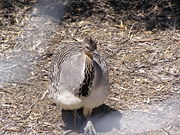
Gum Lagoon Conservation Park
Encyclopedia

Nature reserve
A nature reserve is a protected area of importance for wildlife, flora, fauna or features of geological or other special interest, which is reserved and managed for conservation and to provide special opportunities for study or research...
about 40 km south-west of Keith
Keith, South Australia
Keith is a small farming town in the south-east of South Australia. It is approximately 225 km from Adelaide at the junction of the Dukes Highway and the Riddoch Highway. It is sometimes referred to as the 'lucerne capital of Australia' due to the high number of lucerne growers in the region...
in the Upper South East region of South Australia
South Australia
South Australia is a state of Australia in the southern central part of the country. It covers some of the most arid parts of the continent; with a total land area of , it is the fourth largest of Australia's six states and two territories.South Australia shares borders with all of the mainland...
. It lies about 20 km inland from the southern end of the Coorong. It contains an isolated block of mallee woodland important for Malleefowl conservation.
History
Some 2700 ha formed the core of the reserve when it was originally proclaimed as Gum Lagoon National Park in August 1970. It became the Gum Lagoon Conservation Park in 1972 upon the proclamation of the National Parks and Wildlife Act. It gradually expanded in area through subsequent ad hoc and opportunistic land acquisitions.Description
The reserve contains ranges of calcareniteCalcarenite
thumb|250px|The [[Pietra di Bismantova]] in central [[Italy]] is an example of calcarenite formation.Calcarenite is a type of limestone that is composed predominately, more than 50 percent, of detrital sand-size , carbonate grains...
dune
Dune
In physical geography, a dune is a hill of sand built by wind. Dunes occur in different forms and sizes, formed by interaction with the wind. Most kinds of dunes are longer on the windward side where the sand is pushed up the dune and have a shorter "slip face" in the lee of the wind...
s and interdunal flats, with slow-moving surface water drainage systems and blocks of remnant vegetation. The vegetation includes tea-tree scrub
Shrubland
Shrubland, scrubland, scrub or brush is a plant community characterized by vegetation dominated by shrubs, often also including grasses, herbs, and geophytes. Shrubland may either occur naturally or be the result of human activity...
, wet heath
Heath
-Habitats:* Heath or heathland, low-growing woody vegetation, mostly consisting of heathers and related species* Heaths in the British National Vegetation Classification system...
land and mallee woodland
Mallee Woodlands and Shrublands
Mallee Woodlands and Shrublands is a Major Vegetation Group which occurs in semi-arid areas of southern Australia. The vegetation is dominated by mallee eucalypts which are rarely over 6 metres high...
. The main feature of the park is the Duck Island Watercourse which runs along a wide interdunal flat studded with ephemeral swamps and isolated sandhills. The average annual rainfall is 500 mm.
Flora and fauna
The reserve’s vegetation includes Banksia ornataBanksia ornata
The Desert Banksia is a species of shrub in the plant genus Banksia which grows up to 3 m tall. It occurs in western Victoria, and in South Australia, where it is common on the Eyre Peninsula, Kangaroo Island and east of Adelaide, but is apparently absent from Yorke Peninsula.It tends to grow...
shrubland, Melaleuca brevifolia low shrubland, Eucalyptus arenacea open woodland and Eucalyptus diversifolia open mallee, while the wetter areas are characterised by Red Gum woodland and aquatic herblands
Herbaceous plant
A herbaceous plant is a plant that has leaves and stems that die down at the end of the growing season to the soil level. They have no persistent woody stem above ground...
.
Eleven floristic communities have been identified, containg 375 indigenous plants, including four which are nationally threatened or rare. Native animal species include 12 mammals, 19 reptiles, five amphibians and 141 birds. Also recorded are 62 exotic plants, eight feral mammals and five introduced birds.
Birds
The reserve has been identified by BirdLife InternationalBirdLife International
BirdLife International is a global Partnership of conservation organisations that strives to conserve birds, their habitats and global biodiversity, working with people towards sustainability in the use of natural resources...
as an Important Bird Area
Important Bird Area
An Important Bird Area is an area recognized as being globally important habitat for the conservation of bird populations. Currently there are about 10,000 IBAs worldwide. The program was developed and sites are identified by BirdLife International...
(IBA), principally because it supports an apparently sustainable population of the vulnerable
Vulnerable species
On 30 January 2010, the IUCN Red List of Threatened Species identified 9694 Vulnerable species, subspecies and varieties, stocks and sub-populations.-References:...
Malleefowl
Malleefowl
The Malleefowl is a stocky ground-dwelling Australian bird about the size of a domestic chicken...
, with an estimated population of 13-14 nesting mounds. The biome
Biome
Biomes are climatically and geographically defined as similar climatic conditions on the Earth, such as communities of plants, animals, and soil organisms, and are often referred to as ecosystems. Some parts of the earth have more or less the same kind of abiotic and biotic factors spread over a...
-restricted Purple-gaped Honeyeater
Purple-gaped Honeyeater
The Purple-gaped Honeyeater is a species of bird in the Meliphagidae family.It is endemic to Australia.Its natural habitat is Mediterranean-type shrubby vegetation.-References:...
has also been recorded.
Sources
- BirdLife International (2011) Important Bird Areas factsheet: Gum Lagoon. Downloaded from http://www.birdlife.org on 04/07/2011

